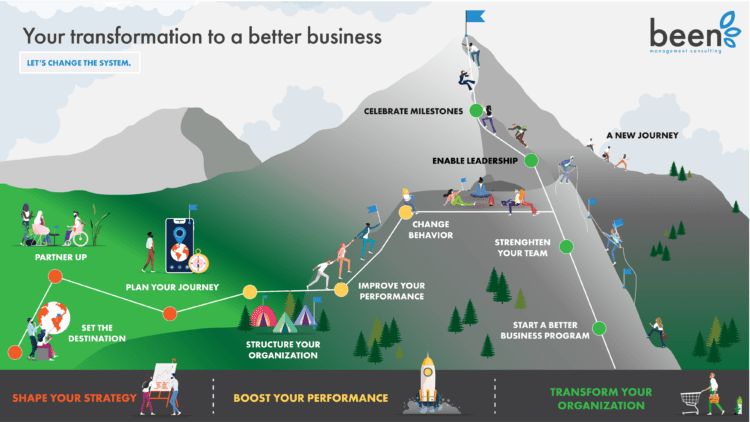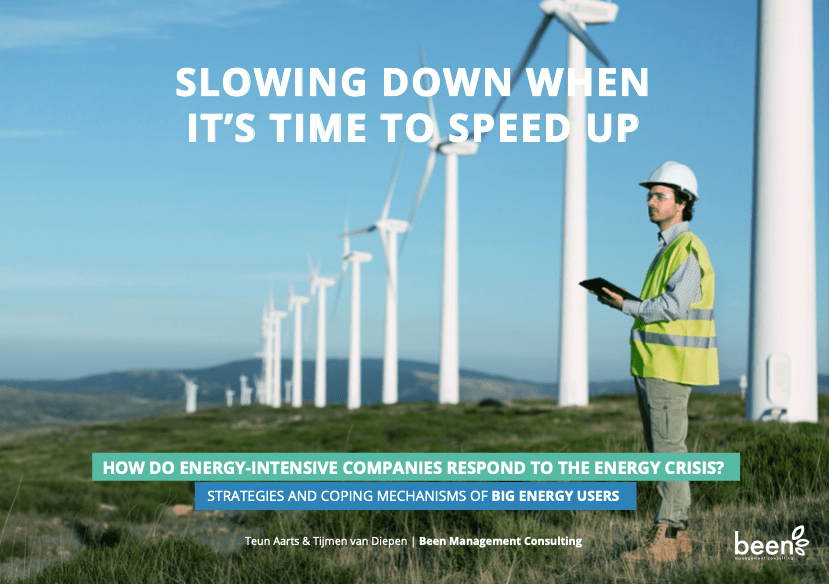Make energy a strategic priority. Incorporate the energy transition in your Strategic Plans. Many companies find it difficult to decide which sources or technologies to invest in. We don’t pretend to know which are the most promising. What we do know: there will not be one dominant energy source anymore. It’s a matter of multiples. And wind power. And solar power. And hydrogen. And …
We cannot change the system by ourselves. As we’ve seen, there are ample barriers to switching to sustainable energy sources. Start a dialogue with parties in your energy value chain. Together with local authorities, suppliers, clients, (competitors even?), you may find solutions to common problems. Perhaps creating opportunities to invest locally in renewable sources, storage, waste streams etc. Or just sharing knowledge to learn from each other. Together, you can form a Coalition for Change.
Assess your potential for reducing energy use and switching to sustainable sources. Make that business case. What investments are needed? How does it all add up? And believe us, energy savings always add up. Also, ensure you incorporate regulatory aspects in your timeline. Stricter laws and regulations are underway. Set up concrete and realistic timeframes.

You must work on changes in both the long and the short term. Create more energy-efficient day-to-day operations whilst making long-term changes to incorporate renewable energy. We recommend you use a framework that distinguishes ‘running the business’ from ‘changing the business’. This way, you create an overview and break down your journey into smaller steps.
Remember: the energy you don’t use is the most sustainable energy. Looking at energy efficiency is the first thing to do. If you haven’t already, put a monitoring system in place to find so-called ‘energy hot spots’. Often coming from equipment that’s old or not being maintained properly. Also, smart monitoring systems can accommodate volatile renewable energy sources. Think of peak-shaving, which relies heavily on monitoring and sharing data to steer energy use. And allows you to use the most energy when it is cheapest.
By incorporating energy efficiency in your day-today operations, you can bring both costs and emissions down on a structural basis. Make sure that the people who use the energy are incentivized to reduce energy. By creating awareness for its strategic importance and rewarding ‘good energy behavior’. We also recommend you use a continuous improvement structure, especially adapted for energy management. Working to create an ‘energy excellence’ culture.
Sometimes, energy is such a central part of your organization. Then switching to sustainable sources becomes a change that affects the entire organization. In that case, I recommend you to pay extra attention to the transformation itself. This starts at the top. The managers who lead this change need to take along all employees along. There are many inspiring and practical interventions that you can use.

You’ll find additional insights and recommendations in the research report. Download it here.
Customer Engagement Manager
Aarzel niet om Iris te bellen via +31 (0)6 10 81 9420.
Of vul het onderstaande formulier in.
Bezoekadres
Hendrik Walaardt Sacréstraat 451
1117 BM Schiphol
© Been Management Consulting 2025
Ultimate beneficial owner: Roel Beentjes